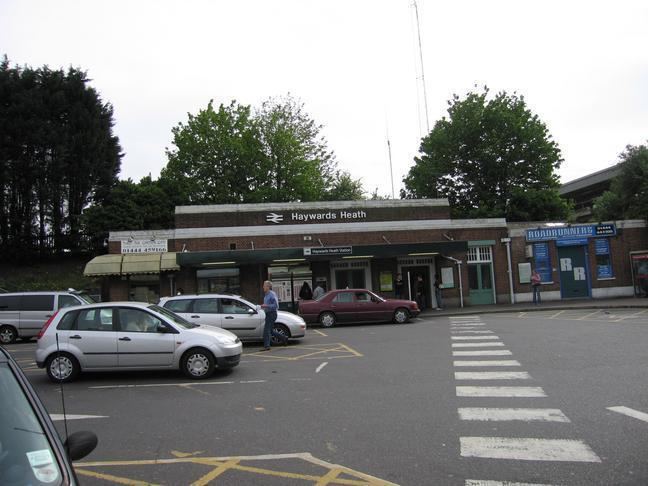Station code HHE 2011/12 4.271 million | Grid reference TQ330245 DfT category B 2012/13 4.339 million Number of platforms 4 | |
 | ||
Similar Three Bridges railway st, Balcombe railway station, Wivelsfield railway station, Gatwick Airport railway st, Redhill railway station | ||
Haywards heath railway station
Haywards Heath railway station is on the Brighton Main Line in England, serving the town of Haywards Heath, West Sussex. It is 37 miles 59 chains (60.7 km) down-line from London Victoria and is situated between Balcombe and Wivelsfield on the main line. It is managed by Southern.
Contents
- Haywards heath railway station
- A scary ghostly apparition at haywards heath railway station
- History
- Layout
- Services
- Northbound
- Southbound
- Freight sidings
- Folly Hill tunnel
- References
Trains calling at Haywards Heath are operated by Southern and Thameslink. Until 2008 a small number of CrossCountry services also stopped here.
A scary ghostly apparition at haywards heath railway station
History
The London and Brighton Railway opened its main line from a junction with the London and Croydon Railway at Norwood as far as Haywards Heath on 12 July 1841, a coach service was provided to take passengers on the remainder of their journey towards Brighton. The remainder of the line to Brighton opened shortly after on 21 September of the same year. The original station was designed by the architect David Mocatta and included a central passing line, and an awning over the platform. The station retained its importance as a junction following the construction of the line to Lewes from Keymer 3 miles (4.8 km) to the south. From 1846 the railway became the London Brighton and South Coast Railway.
On 3 September 1883 the Lewes and East Grinstead Railway opened a branch line from Copyhold Junction, just north of the station, to Horsted Keynes railway station on their existing line between those towns. There was an intermediate station at Ardingly. As a result, Haywards Heath station was enlarged by the provision of two bay platforms. As soon as the line was opened, the Lewes and East Grinstead Railway merged with the London Brighton and South Coast Railway, but until 1912, there was no physical connection between the tracks of the branch line and those of the main line; they ran parallel all the way to Haywards Heath station. Once the connection was made, it provided a relief route for the congested Brighton main line from Croydon to Brighton via Oxted, East Grinstead and Haywards Heath. This double-track branch line was closed to passengers on 28 October 1963, but a single-track section remains to serve a freight and aggregates terminal at Ardingly.
Haywards Heath station was the site of the first use of the practice of "slipping" coaches from the rear of express trains, at intermediate junctions, for onward transmission to smaller stations. The earliest recorded example was in February 1858, when coaches for Hastings were slipped from a London Bridge to Brighton express. This practice was a regular feature at the station until the electrification of the line during 1932/3. The station and surrounding structures such as bridges were also totally rebuilt at this time. A single signal box, alongside Platform 4 (the westernmost platform face), replaced the former North and South boxes.
In 2014, work began on a new "Station Quarter", which would include construction of a new multi-storey car park and footbridge to service the platforms, a new Waitrose supermarket on site and a regeneration of the existing station buildings. The work is scheduled for completion in 2017.
Layout
The platform layout is:
Key:
Services
The typical Monday-Saturday service from the station is:
Northbound
On Sundays the frequency of services to London Victoria increases to 3 trains per hour and the service to London Bridge does not operate.
Southbound
Trains to Littlehampton and to Eastbourne (or Ore) run together between London and Haywards Heath, where they divide.
On Sundays there are 3tph to Brighton, 1tph to Ore and 1tph to Portsmouth Harbour and Littlehampton (train divides at Worthing). Trains to Ore and to Portsmouth and Littlehampton run separately.
Freight sidings
The freight sidings at Haywards Heath were constructed during the First World War when the railway received a rapid growth in its freight traffic as a result of munitions trains travelling to Newhaven. They were intended to enable passenger trains to overtake slower freight traffic.
Folly Hill tunnel
Just south of the station there is a 249-yard (228.6 m) tunnel through Folly Hill. There was an accident during the construction of this tunnel on 2 January 1841, causing a roof fall and killing three men, which prevented the railway from opening through to Brighton in the July. Until the 1970s this tunnel suffered from an excess of water falling from the ground above and in the 1840s it had to be lined with galvanised iron sheeting to prevent the water from falling on the third class passengers in open carriages.
